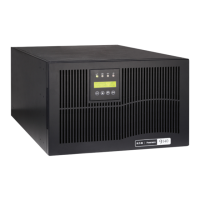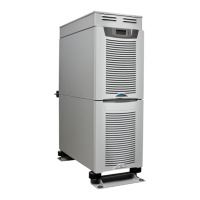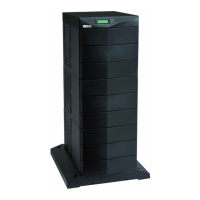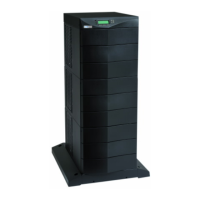www.powerware.com/ibm +44 (0) 845 177 3410
9
Glossary of Power Terms (continued)
Maintenance bypass – An external wiring path to which the
load can be transferred in order to upgrade or perform service
on the UPS without powering down the load.
Make-Before-Break – Operational sequence of a switch or
relay where the new connection is made prior to disconnecting
the existing connection, also soft-load-transfer switching
Noise – (1) A disturbance that affects a signal; it can distort the
information carried by the signal. (2) Random variations of one
or more
characteristics of any entity such as voltage, current or data.
(3) Loosely, any disturbance tending to interfere with normal
operation of a device.
Offline – Any UPS that does not fit the definition of online.
Line-interactive and standby topologies are offline.
Ohm – The unit of measurement for electrical resistance or
opposition to current flow.
Online – (1) A UPS that provides power to the load from its
inverter 100% of the time, regulating BOTH voltage and
frequency, usually double conversion topology.
Orderly Shutdown – The sequenced shutdown of units
comprising a computer system to prevent damage to the
system and subsequent corruption or loss of data.
Plug-and-Play – An electrical device that does not require
extensive setup to operate.
p5 Servers – The most current generation of the IBM System
p® server family that uses IBM’s POWERt architecture
designed for AIX and Linux.
Power Factor (PF) – The ratio of real power to apparent
power. Watts divided by VA. Most power supplies used in
communication and computer equipment have a power factor
of 0.7.
(PF = 0.7)
VA x PF = W
W/PF = VA
Power Sag – Low voltage (below nominal 230 volts).
Power Surge – High voltage (above nominal 230 volts).
Rackmount – Ability to mount an electrical assembly into a
standardized rack.
Rectifier – UPS component that converts incoming AC power
to DC power for feeding the inverter and for charging the
battery.
Redundancy – Duplication or repetition of elements in
electronic equipment to provide alternative functional channels
in case of failure.
Relay Communication – Communication between a UPS and
a computer through the opening and closing of solid-state
relays which are pre-defined to indicate UPS status.
RS-232 – The standard for serial interfaces (serial refers to the
eight bits of each character successively sent down one wire)
used by most computers, modems and printers; a 25-pin
physical interface.
Sine Wave – A waveform that represents periodic oscillations
of a pure frequency.
Single-Phase – Power system with one primary waveform.
Standby – UPS technology where power is applied to the load
directly from the utility under normal operation, but switched to
the inverter and battery for emergency support (offline
topology).
System I™ Server – One of a family of general-purpose
systems that supports IBM i5/OS and Operating System 400
and that provides application portability across all models.
Formerly known as iSeries server.
System p™ Servers – The IBM server family that uses IBM’s
POWER architecture designed for AIX and Linux operating
systems. Formerly known as pSeries server.
System x™ Servers – The product name of an IBM eServer™
product that emphasizes industry-standard server scalability
and self-managing server technologies. It is the successor to
the Netfinity® family of servers. Formerly known as xSeries
server.
Three-Phase – A power system with three primary voltage
waveforms spaced equally (in time) out of phase with each
other.
Total Harmonic Distortion (THD) – Describes how much the
circuit voltage deviates from a perfect sine wave. A poor
voltage THD is most often manifested in a “flat topped”
waveform that comes from the inability of a power source to
respond to the demands of highly non-linear loads.
Uninterruptible Power System (UPS) – An electrical system
designed to provide instant, transient-free back up power
during power failure or fault. Some UPSs also filter and/or
regulate utility power (line conditioning).
Volt/voltage (V) – Electrical pressure that pushes current
through a circuit. High voltage in a computer circuit is
represented by 1; low (or zero) voltage is represented by 0.
Volt Amps (VA) – Voltage x amps.
Volts Direct Current (Vdc)
Volts Alternating Current (Vac)
Watts (W) – The rate of doing electrical work.
W x 1.3 = VA.

